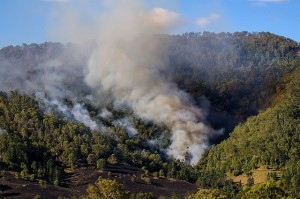Our Top Recommendations for Bushfire Risk Management for Summer 2021-22
December 28, 2021 - 3 minutes read
Smoky hills
We might have been experiencing some wetter-than-usual conditions this summer, but in Australia the bushfire risk is never far away!
According to AFAC (the National Council for Fire and Emergency Services), parts of WA and inland NSW face a higher-than-normal risk for bushfire this summer. The rest of the country carries a largely ‘normal’ fire potential, apart from some regions on the east coast which currently have a lower-than-usual risk.
But even after a lot of wet weather, it doesn’t take long for a region to dry out and for the risk of bushfire to rear its head all over again! So it’s always important to be prepared.
Preparing for bushfire isn’t a one-off act but needs to be continuous throughout the year. Here are some tips for risk reduction and developing a bushfire plan.
Prepare your property
Bushfire risk is increased by certain factors such as sloping topography, dry vegetation, flammable plants, and intense winds.
Year-round maintenance reduces the risk. This includes:
- creating a defensible space around your building (30m is recommended)
- keeping grass mowed and short (preferably under 10cm)
- removing dry and dead matter from roofing gutters and around the property
- regular pruning of plants
- caring for mature trees
- ‘fire-wise’ planting – for example, avoiding plants with course or fibrous bark, trees that retain dead leaves rather than shedding them, or plants with leaves that contain volatile oils.
Create a bushfire and disaster recovery plan
A bushfire plan ensures you are ready ahead of time in the event of fire. Considerations for this include:
- keeping informed of bushfire risk through your local emergency services app or local radio or TV channels
- checking local fire-danger ratings
- deciding on the triggers for enacting your plan
- procedures for evacuation, emergency kits, communication with emergency authorities, organising important documents, protecting data, and switching off utilities
- continuity planning to help ensure you can keep operating during and after catastrophes
- disaster recovering planning for returning to normal operations.
Keep up with your insurance
While risk management can reduce the risk of harm it cannot prevent bushfires from occurring. This is where insurance comes in, as it provides financial protection in case of losses due to bushfires and other catastrophes. This includes building and contents cover and consequential loss or interruption insurance.
For additional guidance on church risk management or to discuss your insurance policy, call us on 03 9488 8800 or send an email to hello@cofcinsurance.org.au
Helpful links and resources
- CCI – disaster recovery planning
- Ansvar – property risk management resources and checklists
- Red Cross – state-wide links and resources for bushfire planning
Written by Tess Oliver
Tags: emergency, fire, weather
Recent Comments